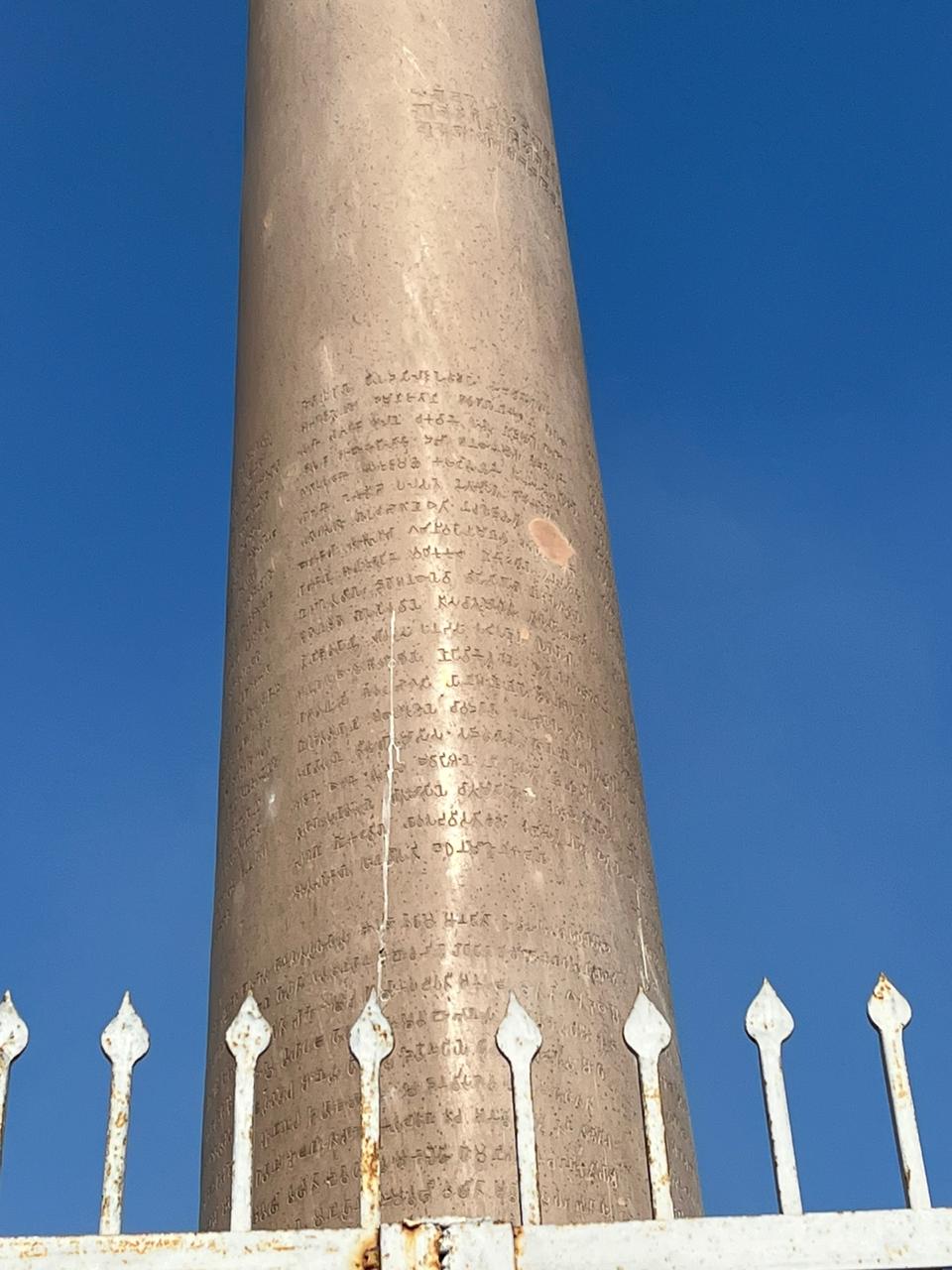LEGACY OF ASHOKAN PILLARS IN DELHI: A JOURNEY THROUGH MAURYANS TO TUGHLAQS
- enrouteI
- August 12, 2023

The control of Magadh, which corresponds roughly to modern-day Bihar, was at the heart of political action in ancient India. Around 321-297 BCE, Magadha was under the rule of Nanda Dynasty. Chandragupta Maurya overthrew them and established the first pan-Indian empire of ancient India- “The Mauryan Empire” which lasted from approximately 321-185 BCE. The second Mauryan ruler was Bindusara, after which Aśoka became his successor.
Ancient Buddhist texts (e.g., Aśokavandana, Divyavadana, Ceylonese sources) list prophecies about Aśoka’s birth, reign, and life events. These include curbing the Taxila revolt, becoming Ujjaini’s viceroy, and committing cruelties like slaying 99 brothers for the throne. Exaggeration is probable in these accounts, portraying him as morally flawed before his conversion to Buddhism.
Opinions vary on Aśoka’s conversion to Buddhism. Some believe it happened immediately after the Kalinga War, driven by remorse for the suffering he caused. However, scholars like Eggermont argue that solid evidence is lacking and propose that the conversion occurred before the war.
Ceylon’s chronicles center around the Nigrodha who was the posthumous son of Sumana, the eldest brother of Aśoka, Nigrodha had become a monk and preached to the monarch who was so impressed by the teachings that he accepted Buddhism. The Divyavadana narrates a story wherein Samudra, an ex-merchant who had become a monk, was imprisoned for torture, but by his miraculous powers managed to save himself Aśoka thus converted to Buddhism. the Aśokavadana narrates a similar story with a twelve-year-old monk unhurt by torture as the catalyst behind the conversion.
Whatever may be the chronology and intensity of Aśoka’s conversion, this is certain that he left behind abounding edicts, written in the local dialects of Pali, Prakrit, Greek, and Aramaic, in various locations around his empire propagating his concept of Dhamma (Prakrit for ‘Dharma’ or duty) which was influenced by Buddhism however, inherently different from it in many ways. The central theme was Ahimsa or non-violence but it went on to describe the duty of the king and the subjects. Some historians regard Dhamma as a ‘universal religion’ or ‘Raj Dharma’ (royal duty). Romila Thapar opines that the propagation of Dhamma had political motives of consolidating a far-flung empire and practical advantages of spreading an ethical concept that focussed on the relationship between individuals and society.
Firoz SHAH TUGHLAQ AND THE ASHOKAN PILLARS
There was a gradual decline in the luster of Mauryans after the reign of Aśoka and the empire came to an end in 185 BCE. Over the centuries the seat of power in the northern plains of India shifted to the Ganga-Yamuna Doab area. During the medieval era, the vicinity which corresponds roughly to modern-day Delhi became eminent, here, the Tughlaq dynasty was established in 1320 CE by Ghias-Ud-Din Tughlaq. Firoz Shah Tughlaq came to the throne in 1351 CE. He constructed the sixth of the many cities of Delhi, known as Firozabad wherein he built his fort Feroz Shah Kotla.

Conjectural drawing of the Firuz Shah Kotla Fort, Delhi. (J. A. Page, ‘A Memoir on Kotla Firoz Shah, Delhi with a Translation of Sirat-i Firozshahi’, Memoirs of the Archaeological Survey of India 52 (1937), Plate II.)
In 1356 CE, while hunting near the village of Topra, near Khizrabad, in present-day Haryana, the sultan came upon a standing stone pillar cut from a single block of stone. It was lustrous and polished which caused it to shine like gold. Furthermore, it was one of two columns – the other located in Meerut.
He wanted to understand their significance. He made exhaustive inquiries from pandits and discovered that according to local legend, the two pillars were of the time of Mahabharata and were the walking sticks of the Bhim, one of the five Pandava brothers, a giant of massive strength and size. When Bhim died these columns were left standing as memorials to him. Awestruck, Firoz Shah decided to bring them to Delhi as Laurells. Unbeknownst to him, these were pillars erected by Aśoka.
Shams-I-Siraj, a contemporary chronicler has recorded the feat of translocating these pillars to Delhi in his book ‘Traikh-Firoz-Shahi’: “Directions were issued for bringing parcels of the cotton of the Sembal tree. Quantities of this cotton were placed round the column, and when the earth at its base was removed, it fell gently on the bed prepared for it. The cotton was then removed by degrees, and after some days the pillar lay safe upon the ground … The pillar was then encased from top to bottom in reeds and raw skins so that no damage might accrue to it. A carriage, with forty- two wheels, was constructed, and ropes were attached to each wheel. Thousands of men hauled at each rope, and after great labour and difficulty the pillar was raised onto the carriage.”
The column was then dragged to the banks of the Yamuna, where it was loaded on large boats tied together and floated to Delhi. Firoz Shah named the pillar “Minar-i-Zarin” (The Golden Pillar).

Wikipedia Commons: [Sirat i-Firuz Shahi 14th century illustration of the transportation of the Topra pillar to Delhi via Meerut]
To erect the pillar at the Kotla Fort, ingenious engineering was employed. A pyramidical building was constructed near the Jami Masjid, with several floors. Each completed story lifted the column higher until it reached the desired height. Ropes of great thickness were used, connected to windlasses on base stages, and the column was raised gradually. Logs of wood and bags of cotton were used as support. After several days, the pillar stood perfectly straight. Ornamental friezes of black and white stone adorned its capitals, and a gilded copper cupola (Kalash) was placed on top. This Capital has since been lost to time. This sandstone pillar now known as Delhi-Topra Pillar is 42 ft 7 in high and weighs 27 tons.

Ashokan Pillar on Pyramidical structure (Image by Shambhavi Sharma, January 2023)

The Kotla of Firoz Shah with the Ashokan pillar viewed from the west, with the gateway of the adjacent mosque (top right), View from the south of the Kotla (bottom right) [Sir Thomas Theophilus Metcalfe, 1843 From ‘Reminiscences of Imperial Delhi’ via Wikipedia Commons
In ‘Sirat-i-Firuz-Shahi’ a possible autobiography of the Sultan, is a poem in Persian for the pillar: ‘No bird, neither eagle, nor crane, can fly up to its top,’ He writes about his curiosity regarding its construction, and how its makers were able ‘to paint it all over with gold so as to make the people think it to be the golden dawn?’ Sultan ends by wondering what the golden column is: ‘Is it the Tuba [Lote-tree of Paradise] which the angels have planted on the earth, or is it the Sidya [ Plum-tree of Paradise] which men have taken to be a mountain?’
During Timur’s plunder of Delhi, he visited the mosque at Firoz Shah Kotla fort to pray. There, he encountered the pillar and remarked that he had never seen a monument as remarkable as this anywhere.

Kotla Firoz Shah with Ashokan Pillar
Two and a half centuries later the trader William Finch visited Shahjahanabad which was being laid north of the ruins of Firozabad by Mughal emperor Shahjahan. Here he inspected the column of gold, then known as Firoz Shah’s Lat or ‘staff’, and concluded that its unintelligible lettering was some form of Greek, most likely set there by Alexander the Great to mark his victory over the Indian ruler Poros.
The Delhi-Meerut Pillar was re-erected as the centerpiece of a hunting lodge called Kushq-i-Shikar, presently in Delhi Ridge. Unfortunately, it was severely damaged in an explosion during the reign of Mughal emperor Farrukhsiyar, breaking into five pieces. In 1838, Hindu Rao acquired the pieces and gifted them to the Asiatic Society of Bengal where they were joined together. The pillar returned to Delhi in 1866 and was reassembled a year later, finding its current location in 1867, standing at a height of 10 m. Finch described the pillar as having a globe and half-moon at the top with diverse inscriptions.

Inscribed plaque of Delhi-Meerut Pillar (Image by Shambhavi Sharma, February 2023)
It was not until the formation of the Asiatic Society of Bengal in 1784 CE and their exhaustive research into ancient Indian history that the modern audience got to know the pillars were erected by Aśoka to propagate his Dhamma.
The Delhi-Topra pillar has seven edicts, according to D. R. Bhandarkar the seventh one was perhaps added later and is not found anywhere else. It contains several codes of conduct that seek to promote the well-being of society and philosophical positions, of which toleration was an essential part. Alexander Cunningham observed two significant inscriptions on the pillar. The first, in ancient Pali, was made by Aśoka, while the second, in Sanskrit, recorded the victories of Chohan Prince Visala Deva in 1163 CE., Cunningham also mentioned several minor inscriptions of different ages ranging from Gupta period to one bearing the name of Sultan Ibrahim Lodi c. 1524 CE. The Delhi-Meerut pillar contains six edicts same as those of the Delhi-Topra pillar.

Inscriptions on Delhi-Topra pillar (shambhavi sharma, January 2023)
These ancient pillars carry the weight of history and the legacy of Aśoka’s vision. The engravings on the pillar speak of civilization’s triumphs from ancient India to medieval Delhi. These pillars are not just relics of the past; they hold a timeless lesson in compassion, and hope, inspiring generations to come.
REFERENCES:
Allen, Charles. Ashoka: The Search for India’s Lost Emperor. 2012
Nath R., Nath Ajay. Monuments of Delhi: Architectural and Historical (translation of Syed Ahmed Khan’s Urdu work ‘Athar’al-Sanadid’ of 1846). 2010
Mookerji R.K. “Chandragupta Maurya and His Times”. 1966
Delhi Chapter, INTACH. Delhi The Built Heritage; A listing. Volume 1.
Lahiri, Nayanjot. Ashoka in Ancient India. 2015.
Thapar, Romila. Asoka and the Decline of the Mauryas. (2012).
Mukherjee, Debyani. “The Asokan Minor Rock Edict in Bahapur, Delhi.” International Journal of Architectural Heritage, Taylor and Francis, Jan. 2022.
Mookerji, Radhakumud. Asoka. Motilal Banarasidas. 1962
Page J.A, A.R.I.B.A. “Memoirs of the Archaeological Survey of India, No. 52. A memoir of Firoz Shah Kota, Delhi ”. 1937
- May 15, 2024
- 6 Min Read

























